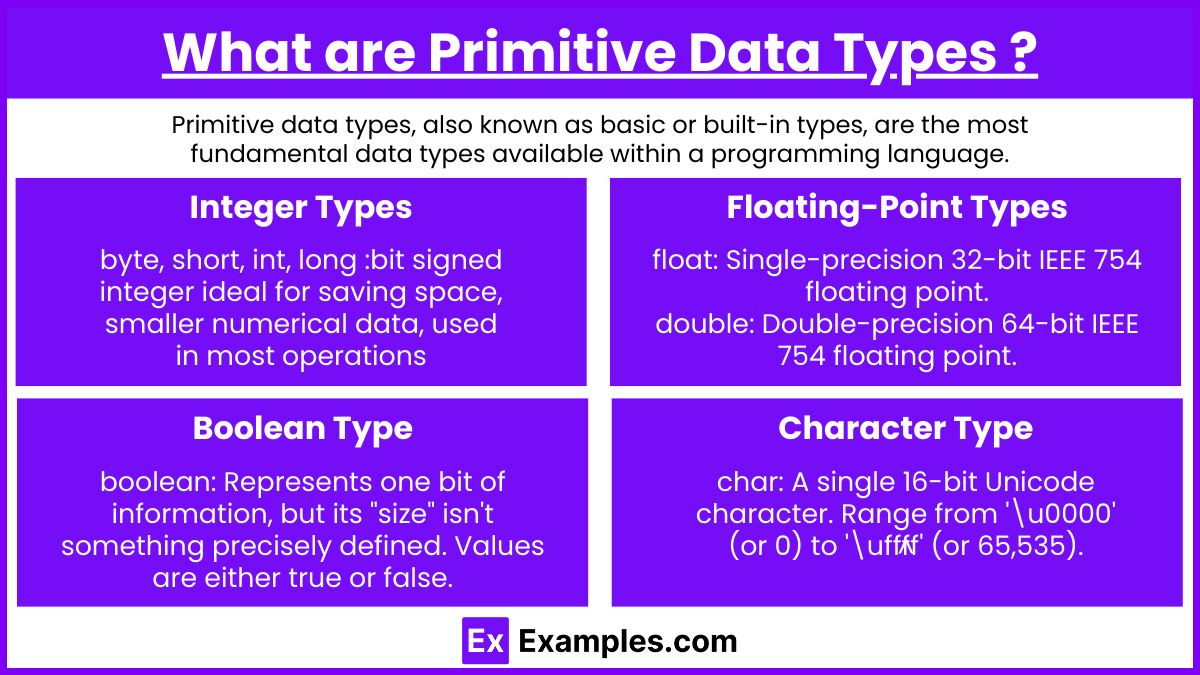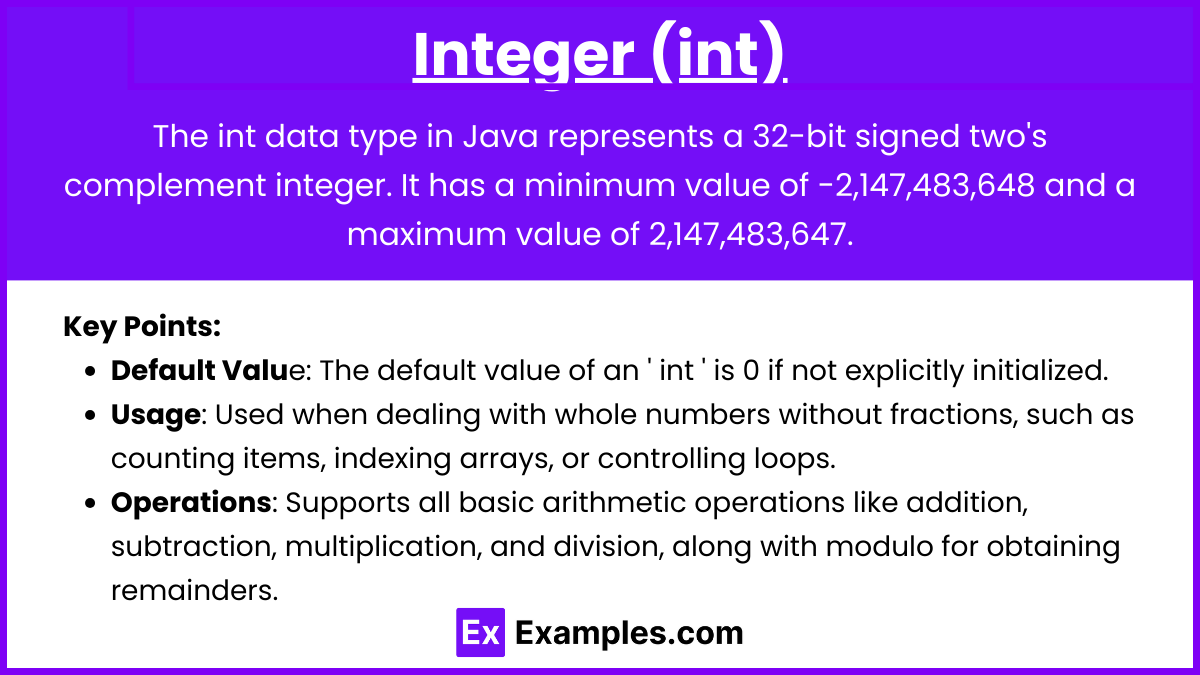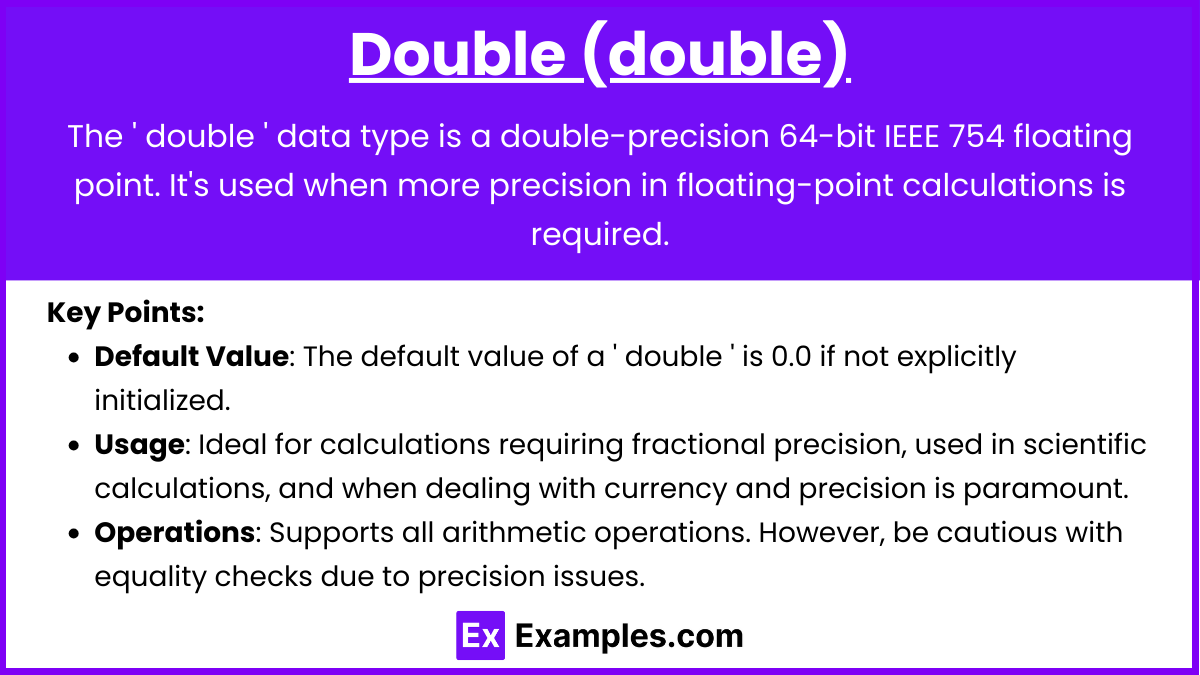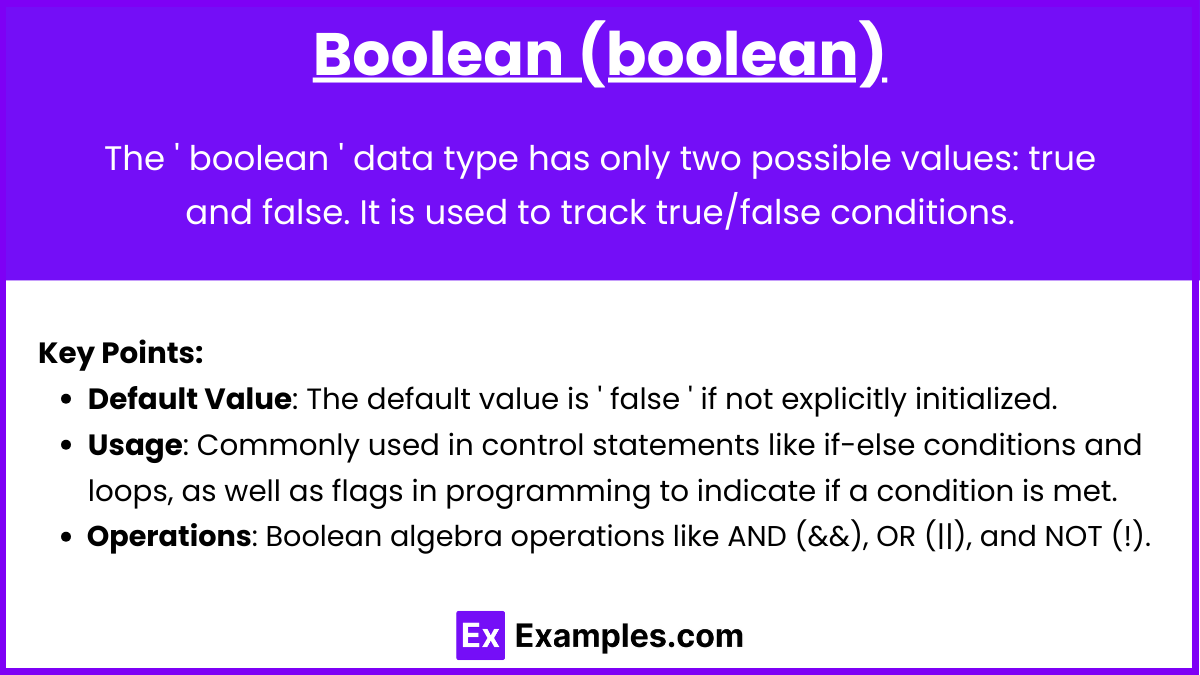In AP Computer Science A, understanding primitive data types is fundamental to mastering Java programming. These types, including int, double, and boolean, form the building blocks of data manipulation. The int type is used for whole numbers, double for precision-required floating-point numbers, and boolean for true/false conditions. Grasping these types enables students to handle basic operations and control structures effectively, laying the groundwork for more complex programming tasks and efficient problem-solving in computer science.
Learning Objectives
In preparing for the AP Computer Science A exam, focus on understanding the specific characteristics and uses of the primitive data types int, double, and boolean. Learn to identify appropriate scenarios for each type, such as using int for whole numbers, double for precise floating-point calculations, and boolean for true/false conditions. Master the syntax for declaring, initializing, and using these data types in Java. Additionally, grasp concepts of data type conversion, particularly the implications of casting and potential data loss or precision issues.
What are Primitive Data Types ?

Primitive data types, also known as basic or built-in types, are the most fundamental data types available within a programming language. These types serve as the building blocks for data manipulation in many programming languages, including Java, which is commonly used in AP Computer Science A courses. Here are the main primitive data types in Java:
byte is an 8-bit signed integer ideal for saving space with a range of -128 to 127. short is a 16-bit signed integer suitable for smaller numerical data, ranging from -32,768 to 32,767. int is the standard 32-bit signed integer used in most operations, with a range from -2,147,483,648 to 2,147,483,647. long offers a 64-bit signed integer for very large values, ranging from -9,223,372,036,854,775,808 to 9,223,372,036,854,775,807.
- Integer Types
- byte: 8-bit signed integer. Range from -128 to 127.
- short: 16-bit signed integer. Range from -32,768 to 32,767.
- int: 32-bit signed integer. Range from -2,147,483,648 to 2,147,483,647.
- long: 64-bit signed integer. Range from -9,223,372,036,854,775,808 to 9,223,372,036,854,775,807.
- Floating-Point Types
- float: Single-precision 32-bit IEEE 754 floating point.
- double: Double-precision 64-bit IEEE 754 floating point.
- Boolean Type
- boolean: Represents one bit of information, but its “size” isn’t something precisely defined. Values are either true or false.
- Character Type
- char: A single 16-bit Unicode character. Range from ‘\u0000’ (or 0) to ‘\uffff’ (or 65,535).
Integer (int)

The int data type in Java represents a 32-bit signed two’s complement integer. It has a minimum value of -2,147,483,648 and a maximum value of 2,147,483,647.
Key Points:
- Default Value: The default value of an ‘ int ‘ is 0 if not explicitly initialized.
- Usage: Used when dealing with whole numbers without fractions, such as counting items, indexing arrays, or controlling loops.
- Operations: Supports all basic arithmetic operations like addition, subtraction, multiplication, and division, along with modulo for obtaining remainders.
Example:
int count = 10;
int result = count * 5; // Result is 50Double (double)

The ‘ double ‘ data type is a double-precision 64-bit IEEE 754 floating point. It’s used when more precision in floating-point calculations is required.
Key Points:
- Default Value: The default value of a ‘ double ‘ is 0.0 if not explicitly initialized.
- Usage: Ideal for calculations requiring fractional precision, used in scientific calculations, and when dealing with currency and precision is paramount.
- Operations: Supports all arithmetic operations. However, be cautious with equality checks due to precision issues.
Example:
double temperature = 98.6;
double height = 172.5;Boolean (boolean)

The ‘ boolean ‘ data type has only two possible values: true and false. It is used to track true/false conditions.
Key Points:
- Default Value: The default value is ‘ false ‘ if not explicitly initialized.
- Usage: Commonly used in control statements like if-else conditions and loops, as well as flags in programming to indicate if a condition is met.
- Operations: Boolean algebra operations like AND (&&), OR (||), and NOT (!).
Example:
boolean is JavaFun = true;
boolean isFishTasty = false;
if (isJavaFun && isFishTasty) {
System.out.println("Enjoy your meal and coding!");
}
else { System.out.println("Coding is still fun!");
}Characteristics of Primitive Data Types
- Efficiency: They are highly efficient in terms of computation and storage because they are directly handled by the computer’s hardware.
- Storage: Each type has a fixed size and range.
- Default Values: Each primitive type has a default value when declared as a variable, such as 0 for numeric types, false for boolean, and ‘\u0000’ for char.
- Stack Storage: Primitive types are stored on the stack, which makes access to them faster.
- No Methods: Being primitive, these types do not have methods; they are simple values.
Examples
Example 1: Temperature Conversion (int to double)
An ‘ int ‘ variable named ‘ tempCelsius ‘ stores the temperature in degrees Celsius. To convert this temperature to Fahrenheit, which might require a decimal place, you use a ‘ double ‘. Here’s the calculation:
int tempCelsius = 25;
double tempFahrenheit = (tempCelsius * 9/5.0) + 32; // Result is 77.0This example demonstrates how an integer can be used in a calculation that converts to a double for greater precision.
Example 2: Grade Evaluation (boolean)
A ‘ double ‘ variable ‘ testScore ‘ holds a student’s score in a test. A boolean variable ‘ isPassing ‘ determines if the score exceeds a passing threshold:
double testScore = 72.5;
boolean isPassing = testScore >= 70; // Result is trueThis uses a double for detailed measurement and a boolean to store a logical condition’s result.
Example 3: Loop Counter (int)
An ‘ int ‘ is often used as a loop counter because it’s perfect for indexing and counting, given its range and properties. Here’s a typical for-loop:
for (int i = 0; i < 10; i++) {
System.out.println("Loop iteration: " + i);
}The int variable i serves as a straightforward counter for the number of loop iterations.
Example 4: Banking App Balance Check (boolean and double)
In a simple banking app, a ‘ double ‘ holds the account balance, and a ‘ boolean ‘ checks if the balance is sufficient for a withdrawal request:
double accountBalance = 500.00;
boolean canWithdraw = accountBalance >= 100.00; // Result is trueThis example combines ‘ double ‘ for financial figures, which require precision, and ‘ boolean ‘ to make decisions based on those figures.
Example 5: Sensor Value Check (int and boolean)
A sensor sends readings as whole numbers (‘ int ‘), and a system checks if the reading is within an acceptable range using a ‘ boolean ‘:
int sensorReading = 450;
boolean isNormal = sensorReading >= 400 && sensorReading <= 600; // Result is trueThe ‘ int ‘ here captures a discrete measurement from the sensor, while the ‘ boolean ‘ is used to validate if the reading falls within a normal operating range.
Multiple Choice Questions
Question 1
What will be the result of the following Java code?
int a = 50;
int b = 9;
double c = a / b;A) 5.0
B) 5.5555…
C) 5
D) 5.5556
Correct Answer: C) 5
Explanation: In this code, both a and b are declared as int. When you divide two integers in Java, the result is also an integer, which means it will not show any decimal points, and the fractional part is truncated. The variable c is a double, but it receives the truncated integer result of the division, which is 5.
Question 2
Which statement about the boolean data type is true?
A) boolean types can store values true, false, or null.
B) boolean types can hold any integer value, with 0 being false and any other value being true.
C) boolean types are used to represent one bit of information – true or false.
D) boolean types are used to store numbers with decimal precision.
Correct Answer: C) boolean types are used to represent one bit of information – true or false.
Explanation: The boolean data type in Java is used to store one of two possible values: true or false. It does not accept null (unless it is a Boolean object, the wrapper class for boolean), nor does it store any numerical value. boolean is strictly for true/false conditions.
Question 3
Consider the following Java code snippet:
double pi = 3.14159;
int number = (int) pi;What will be the value of number after this code is executed?
A) 3.14159
B) 3
C) 3.0
D) 4
Correct Answer: B) 3
Explanation: This example demonstrates explicit type casting from double to int. The variable pi has a value of 3.14159, which is a double. When casting to int, the decimal portion is simply dropped, and not rounded. Thus, number will have a value of 3, losing the fractional part entirely.


